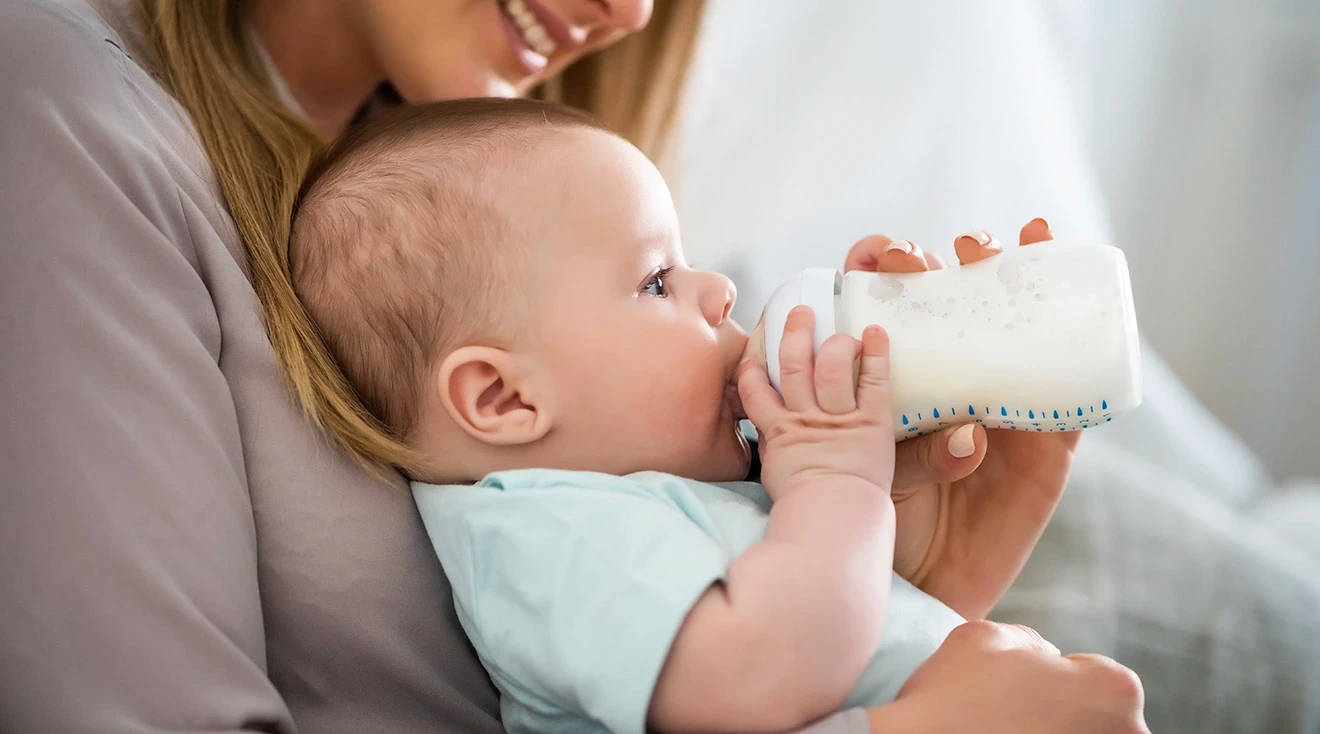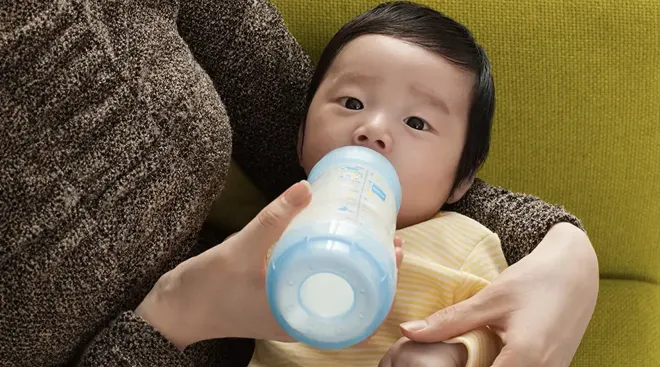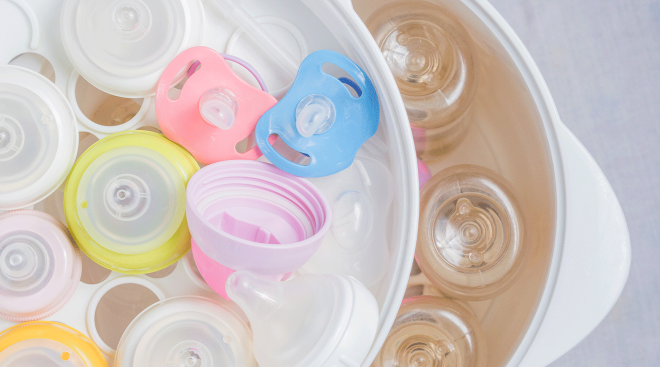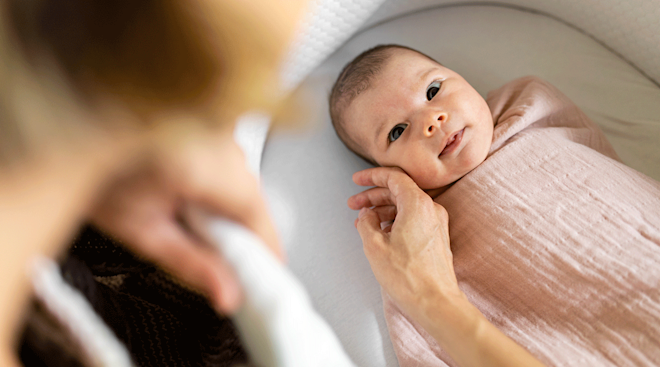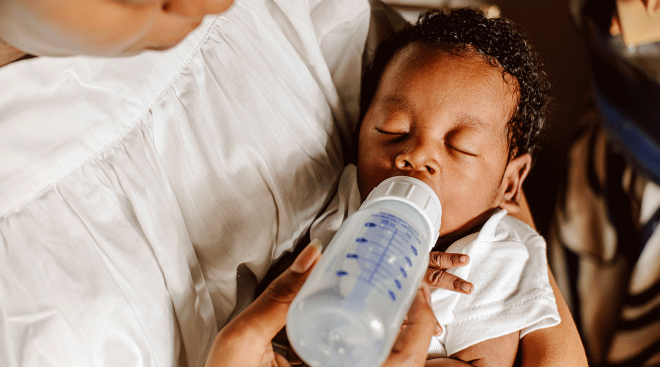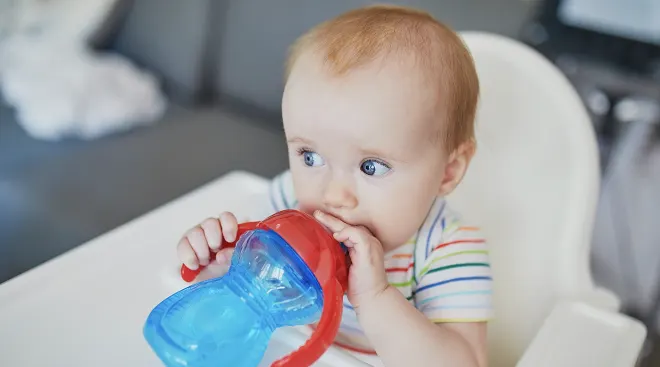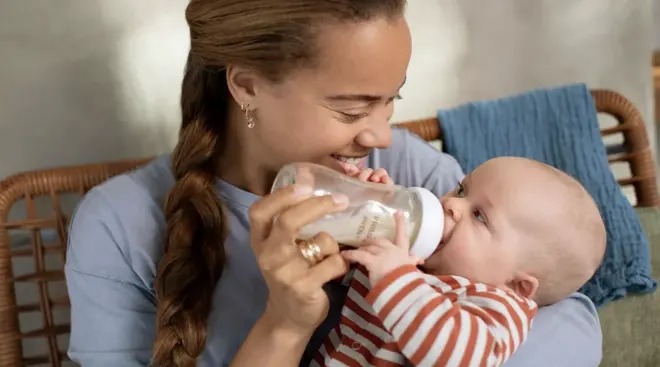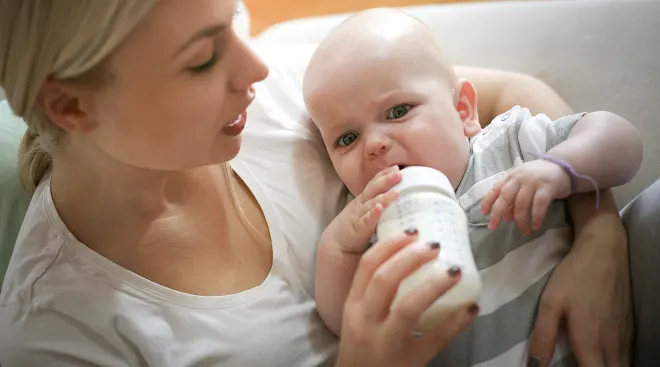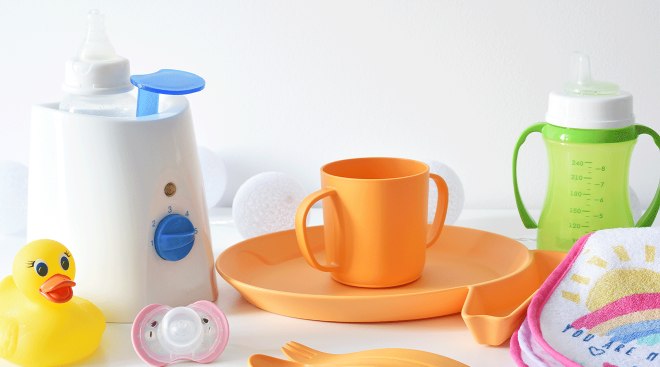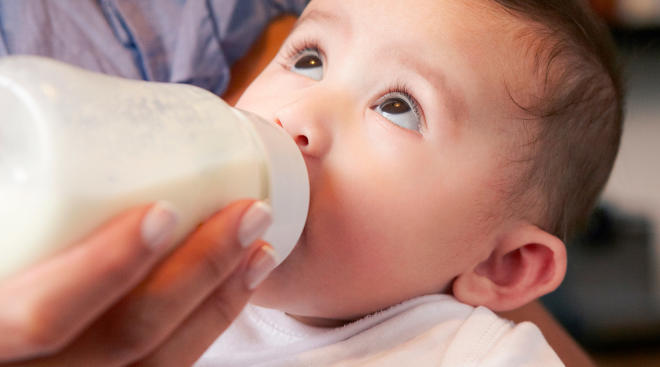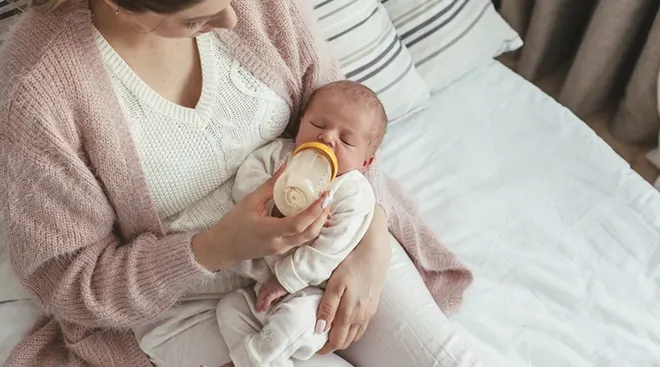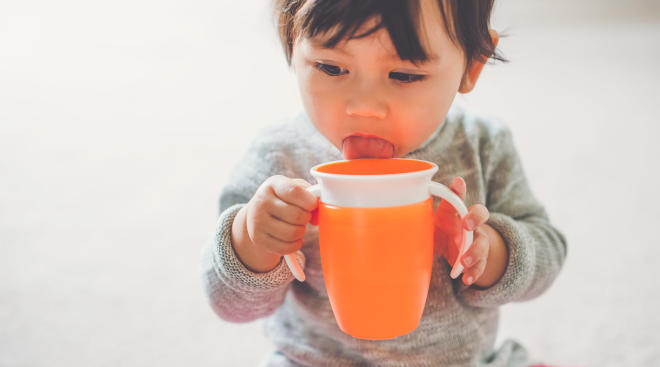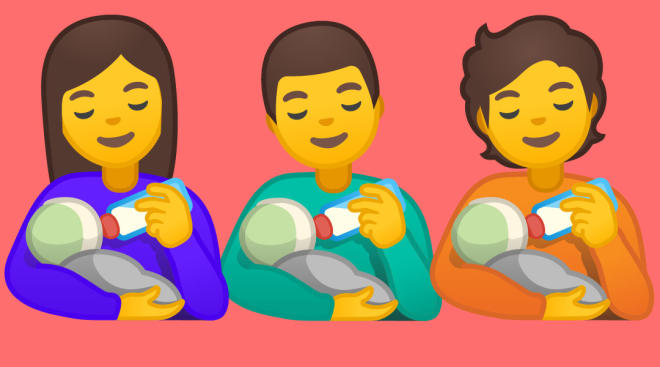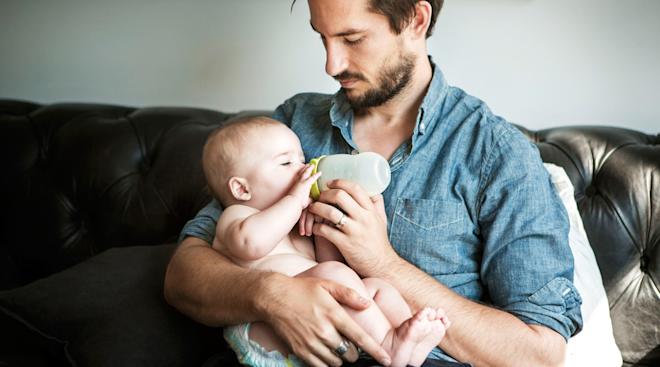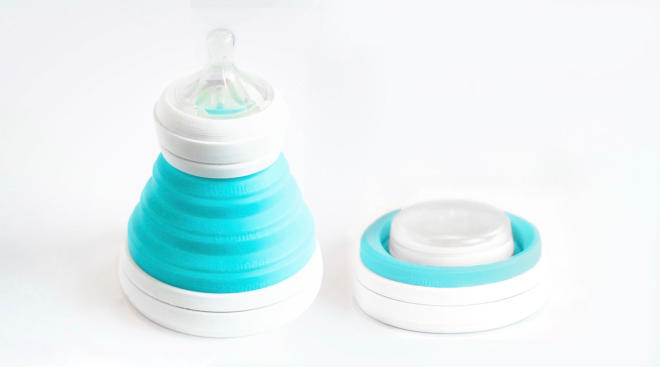When Do Babies Hold Their Own Bottle?
Giving baby a bottle can be a wonderful bonding experience in the first year of parenthood. But, with all you have to do, it’d surely be nice to get your hands back at some point. So when do babies start holding their own bottle? Ultimately, it’s up to baby to decide when they’re ready to serve themselves, but there are a few things you can do to help get them ready. After all, baby holding a bottle is an important milestone. It’s a sign that their brain and muscle development is right on track—and a tiny reminder for caregivers that taking care of baby does get easier. So when do babies hold their own bottles, and how can you help them along? Read on for the answers.
When do babies start holding their own bottle? It’s a question many parents ask. “Most babies will start holding their own bottles between 6 to 10 months, as their fine-motor skills develop,” says Sandeepa Rajadhyaksha, MD, a pediatrician with Cook Children’s Pediatrics in Frisco, Texas. But, as is the case with many things, every baby is different, and the typical window for when babies start holding a bottle can be wide. Some learn to hold the bottle pretty early on, others take their time—and both are okay. “Be patient,” advises Rajadhyaksha. Plus, be aware that this is the starting age range, meaning “they may not hold the bottle consistently or for the entire feeding,” says Denise Scott, MD, an Oklahoma-based pediatrician.
It’s also important to note once baby can hold their own bottle, they can usually hold a sippy cup as well, Scott adds. “Some cups are held similarly to a bottle, and others have handles that can make it easier.”
Eager to see baby holding a bottle, but not sure if they’re ready? If you watch carefully, your child will give you clues they’re ready to get more involved at mealtimes—and many of them have to do with hitting milestones and baby’s overall development. Here are some signs to look for:
-
Baby can sit up for 10 minutes by themselves: Holding a bottle is a fine-motor skill, and it requires baby to be able to stabilize themself, says Melanie Potock, MA, CCC-SLP, a Denver-based pediatric feeding expert and co-author of Baby Self-Feeding. (Plus, it’s safest for baby to self-feed in an upright, seated position.)
-
Baby reaches for their bottle: If baby is reaching for or putting their hands on the bottle as you feed them, it’s a sign they may be ready to hold it, Scott says. This shows interest and cognitive development, and that baby is starting to associate the bottle with food. Similarly, Scott cites baby bringing food that’s been handed to them to their mouth as another sign that they may be ready for bottle holding.
-
Baby sits and reaches for items: If baby reaches for objects and brings them to their mouth while sitting (i.e. gnawing on toys while they’re seated independently), they’re essentially multitasking, and they may be ready to hold their own bottle, Scott says.
You’ve been watching carefully, and baby is starting to display signs they’re ready for bottle holding. So how can you help baby hold a bottle? The best thing to do is practice, Potock says. “Holding a bottle doesn’t happen overnight. It happens in stages.” Below, some ways to encourage baby holding a bottle:
-
Do lots of tummy time: This enhances core strength. “Babies need to develop trunk support in the first six months of life in order to hold objects relatively still in front of their mouths with both hands,” Potock says. “Add coordinated sucking, swallowing and breathing to the task of holding a bottle independently, and it’s not that easy!” Tummy time also helps baby work on their independent sitting skills, which is important since babies should be upright when feeding themselves from the bottle, Scott notes.
-
Use teething toys: Potock suggests bringing these to baby’s mouth while they’re sitting to help them practice. “This helps baby use the same neck and facial muscles they’ll need to hold and drink from the bottle,” she explains.
-
Guide baby’s hands when you’re feeding: Start by positioning them in your arms as if you’re going to feed them, then guide their hands around the bottle. “Once they’ve mastered the skill of holding the bottle, watch to see if baby puts it to their mouth,” Rajadhyaksha adds. If they don’t, place your own hands over theirs.
-
Choose the right feeding gear: Using a cylindrically shaped nipple (as opposed to “breast-shaped” or “orthodontic”) can help with correct tongue positioning, Potock says. “You can also add a BPA-free silicone bottle band to help baby know where to grasp and to reduce slipping,” she adds. Though not entirely the same as holding a bottle, Scott also recommends using sippy cups with handles, as they may be easier for baby to hold and grasp.
If baby can’t yet hold their bottle, it can be tempting to prop the bottle up with cushions and have baby “sit” in the corner of the couch to feed. But, as much as you want your hands back, experts strongly caution against bottle propping. It can be incredibly dangerous, as baby could tip over and fall, Potock says, or even suffocate on whatever is being used to prop the bottle up, Scott adds. Plus, bottle propping can also contribute to overeating and even choking, since babies can’t regulate how much to take in when the milk is free-flowing, Rajadhyaksha says. “There’s also a risk for ear infections and tooth decay if the child falls asleep with the bottle in their mouth or continues to suck on it.”
Even once baby can hold their own bottle, it’s important to keep an eye on them as they feed. As Potock explains, you’d never give a child who’s starting on solids a plate full of food and walk away—the same goes for a bottle of milk. “Infants should never be left unsupervised with food or drink due to choking and aspiration risks,” Scott warns. Besides, even after baby can start to hold their own bottle, feedings should still remain a time for bonding. “Children feel a sense of warmth and security when they’re held during feedings,” Rajadhyaksha adds. “Even when your infant can drink independently, you should hold and cuddle baby.”
Don’t worry too much if baby refuses to hold their bottle. “Some babies have no interest in holding their own bottle. A baby is sometimes perfectly content to let you do the work,” Scott says. Plus, it’s important to know that exclusively breastfed babies often go straight from feeding at the breast to a sippy cup. If your little one isn’t holding their own bottle yet, Scott recommends parents continue to encourage them and watch for other skills, like bringing their hands to their midline and moving objects between hands. “You can also try simply handing baby the bottle to see what they do,” she adds. If baby isn’t displaying any of the required skills needed for holding their bottle by the time they’re one year old, Scott advises flagging it with your pediatrician to ensure baby’s development is on track.
Overall, it’s usually not a big deal if baby’s not holding their bottle. In fact, the American Academy of Pediatrics (AAP) actually recommends introducing a sippy cup at 6 months of age, as this can ease the transition from bottle to cup. Scott says it best: “The days of using a bottle are limited, so don’t sweat it.”
Please note: The Bump and the materials and information it contains are not intended to, and do not constitute, medical or other health advice or diagnosis and should not be used as such. You should always consult with a qualified physician or health professional about your specific circumstances.
Plus, more from The Bump:
Melanie Potock, MA, CCC-SLP, is a pediatric feeding expert with over 20 years of experience, founder of the blog My Munch Bug and co-author of Baby Self-Feeding and Raising a Healthy Happy Eater. She started her career in pediatric speech language pathology and earned her master’s degree in speech sciences from the University of Colorado Boulder, as well as her certificate of clinical competence from the American Speech Language Hearing Association.
Sandeepa Rajadhyaksha, MD, is a pediatrician with Cook Children’s Pediatrics in Frisco, Texas. She received her medical degree from University of Maryland School of Medicine, and completed her pediatric residency at Rutgers University in New Jersey.
Denise Scott, MD, is a pediatrician with JustAnswer and a pediatric endocrinologist based in Oklahoma with over 30 years of experience. Certified in culinary medicine, Scott also runs the blog Feed Future Health and is the author of Feed Your Child’s Future Health: Prevent Disease Before It Starts. She received her medical degree from the University of Texas Medical Branch and completed her residency at the University of Oklahoma Health Sciences Center with a fellowship at the National Institutes of Health.
Healthy Children (American Academy of Pediatrics), From Bottle to Cup: Helping Your Child Make a Healthy Transition, July 2023
Learn how we ensure the accuracy of our content through our editorial and medical review process.
Navigate forward to interact with the calendar and select a date. Press the question mark key to get the keyboard shortcuts for changing dates.
































